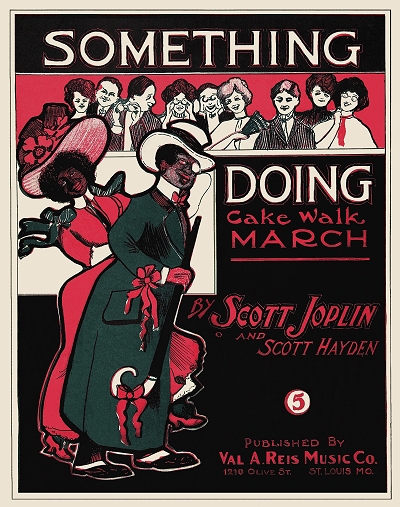|
Scott Hayden (March 31, 1882 to September 16, 1915) | |
 Compositions Compositions | |
Scott Hayden's story is one of the unfortunately common ones of great potential only scantly realized. He was one of the few classic rag composers actually born in the storied "cradle of ragtime" where the genre was informally launched, Sedalia, Missouri. The son of Marion Hayden and Julia Johnican, Scott was the sixth of seven children, including Sarah J. (1868), Mary E. (1869), Fannie (1872), Charles (1875), Earnest (1879), and Julia (10/1884). His paternal grandmother, Littie Hayden, was born in Africa. Scott was fully schooled up through graduation from Lincoln High School, which he attended with another future collaborator of Scott Joplin, Arthur Marshall.
Scott was 17 or 18 when he made the acquaintance of Joplin, who ended up as a tutor and mentor for piano ragtime for both of the youngsters. Although Hayden had already written one unpublished rag (Pear Blossoms which was later completed by ragtime performer and promoter Bob Darch), it was Joplin who was able to take the young musician's skill as a pianist and divert it into compositions. Together they collaborated on four rags, which are still among the more memorable pieces in the Joplin catalog. Coincidentally there were two Scott Haydens listed in the 1900 Federal census. The first entry was on June 4 the budding musician Scottie Hayden, living with his parents and younger sister Julia at 133 Osage Street. The next day, June 5, there is a listing for a white Scott Hayden living four blocks north at 521 Osage Street with his aunt, Sallie Johnson. The two even had the same birth month and year, but they were clearly two different people. To add to the mysterious coincidences, the white Scott Hayden from Sedalia was married just two days after the black Scott Hayden was married, licensed by the same judge no less. As of 1900, three of Marion and Julia's seven offspring had died, including Charlie who had left behind a widow, Belle Jones Hayden. She was lodging in the same Sedalia home as Scott Joplin.
Although Hayden had already written one unpublished rag (Pear Blossoms which was later completed by ragtime performer and promoter Bob Darch), it was Joplin who was able to take the young musician's skill as a pianist and divert it into compositions. Together they collaborated on four rags, which are still among the more memorable pieces in the Joplin catalog. Coincidentally there were two Scott Haydens listed in the 1900 Federal census. The first entry was on June 4 the budding musician Scottie Hayden, living with his parents and younger sister Julia at 133 Osage Street. The next day, June 5, there is a listing for a white Scott Hayden living four blocks north at 521 Osage Street with his aunt, Sallie Johnson. The two even had the same birth month and year, but they were clearly two different people. To add to the mysterious coincidences, the white Scott Hayden from Sedalia was married just two days after the black Scott Hayden was married, licensed by the same judge no less. As of 1900, three of Marion and Julia's seven offspring had died, including Charlie who had left behind a widow, Belle Jones Hayden. She was lodging in the same Sedalia home as Scott Joplin.
 Although Hayden had already written one unpublished rag (Pear Blossoms which was later completed by ragtime performer and promoter Bob Darch), it was Joplin who was able to take the young musician's skill as a pianist and divert it into compositions. Together they collaborated on four rags, which are still among the more memorable pieces in the Joplin catalog. Coincidentally there were two Scott Haydens listed in the 1900 Federal census. The first entry was on June 4 the budding musician Scottie Hayden, living with his parents and younger sister Julia at 133 Osage Street. The next day, June 5, there is a listing for a white Scott Hayden living four blocks north at 521 Osage Street with his aunt, Sallie Johnson. The two even had the same birth month and year, but they were clearly two different people. To add to the mysterious coincidences, the white Scott Hayden from Sedalia was married just two days after the black Scott Hayden was married, licensed by the same judge no less. As of 1900, three of Marion and Julia's seven offspring had died, including Charlie who had left behind a widow, Belle Jones Hayden. She was lodging in the same Sedalia home as Scott Joplin.
Although Hayden had already written one unpublished rag (Pear Blossoms which was later completed by ragtime performer and promoter Bob Darch), it was Joplin who was able to take the young musician's skill as a pianist and divert it into compositions. Together they collaborated on four rags, which are still among the more memorable pieces in the Joplin catalog. Coincidentally there were two Scott Haydens listed in the 1900 Federal census. The first entry was on June 4 the budding musician Scottie Hayden, living with his parents and younger sister Julia at 133 Osage Street. The next day, June 5, there is a listing for a white Scott Hayden living four blocks north at 521 Osage Street with his aunt, Sallie Johnson. The two even had the same birth month and year, but they were clearly two different people. To add to the mysterious coincidences, the white Scott Hayden from Sedalia was married just two days after the black Scott Hayden was married, licensed by the same judge no less. As of 1900, three of Marion and Julia's seven offspring had died, including Charlie who had left behind a widow, Belle Jones Hayden. She was lodging in the same Sedalia home as Scott Joplin.When Joplin moved to St. Louis in 1901, he either married or became a common-law husband to Scott's to Belle. She was shown to have one surviving child of three as of 1900, but whether that child went with them or even survived is unclear. Scott Hayden married Nora Wright on April 17, 1902, when she was evidently several months into a pregnancy, and with his new bride followed the Joplins to St. Louis where they lodged together in the same home. It is likely in this environment that the final three Joplin/Hayden collaborations took shape, although two would not be published for many years. That July, Nora gave birth to the Hayden's daughter, but died within a month, followed by the baby in late August. Since there are no known Scott Hayden compositions written past this point, it may be surmised that both of these deaths had a serious impact on Scott, and his life started to deteriorate from this point on. The 1911 and 1913 releases from publisher John Stark composed in conjunction with Joplin had likely been submitted by 1903, and were simply released during a time when Stark needed some new Joplin material in his catalog as Joplin had been submitting his newer material elsewhere.
but whether that child went with them or even survived is unclear. Scott Hayden married Nora Wright on April 17, 1902, when she was evidently several months into a pregnancy, and with his new bride followed the Joplins to St. Louis where they lodged together in the same home. It is likely in this environment that the final three Joplin/Hayden collaborations took shape, although two would not be published for many years. That July, Nora gave birth to the Hayden's daughter, but died within a month, followed by the baby in late August. Since there are no known Scott Hayden compositions written past this point, it may be surmised that both of these deaths had a serious impact on Scott, and his life started to deteriorate from this point on. The 1911 and 1913 releases from publisher John Stark composed in conjunction with Joplin had likely been submitted by 1903, and were simply released during a time when Stark needed some new Joplin material in his catalog as Joplin had been submitting his newer material elsewhere.
 but whether that child went with them or even survived is unclear. Scott Hayden married Nora Wright on April 17, 1902, when she was evidently several months into a pregnancy, and with his new bride followed the Joplins to St. Louis where they lodged together in the same home. It is likely in this environment that the final three Joplin/Hayden collaborations took shape, although two would not be published for many years. That July, Nora gave birth to the Hayden's daughter, but died within a month, followed by the baby in late August. Since there are no known Scott Hayden compositions written past this point, it may be surmised that both of these deaths had a serious impact on Scott, and his life started to deteriorate from this point on. The 1911 and 1913 releases from publisher John Stark composed in conjunction with Joplin had likely been submitted by 1903, and were simply released during a time when Stark needed some new Joplin material in his catalog as Joplin had been submitting his newer material elsewhere.
but whether that child went with them or even survived is unclear. Scott Hayden married Nora Wright on April 17, 1902, when she was evidently several months into a pregnancy, and with his new bride followed the Joplins to St. Louis where they lodged together in the same home. It is likely in this environment that the final three Joplin/Hayden collaborations took shape, although two would not be published for many years. That July, Nora gave birth to the Hayden's daughter, but died within a month, followed by the baby in late August. Since there are no known Scott Hayden compositions written past this point, it may be surmised that both of these deaths had a serious impact on Scott, and his life started to deteriorate from this point on. The 1911 and 1913 releases from publisher John Stark composed in conjunction with Joplin had likely been submitted by 1903, and were simply released during a time when Stark needed some new Joplin material in his catalog as Joplin had been submitting his newer material elsewhere.Hayden left the Joplin residence for Chicago where many other ragtime figures were heading for its burgeoning music scene. It is reported that Scott was a very adept pianist, so that he did not make it in Chicago may have been a matter of timing, as the 1904 Louisiana Purchase Exposition, also known as the 1904 World's Fair, briefly became the center of ragtime shortly after he moved away from there.
A Scot Hayden with identical parental and age demographics is listed in Chicago in 1910 as a baker (possibly a second job in addition to performance). There was another marriage in the interim, as he wed Missouri-born Maggie Collins on May 28, 1910, the second marriage for both of them. On the marriage certificate they are both 28 years of age. For the 1910 enumeration Scott and Maggie were shown as having been married for at least two years, so had likely been cohabitating as a couple since 1908. This was also the only black Scott Hayden in Chicago in that Federal census record, further bolstering the case for credibility of this find. Hayden married once again on August 12, 1914, this time to Mrs. Jeanette E. (Wilkins) Cook, also previously married.
On the marriage certificate they are both 28 years of age. For the 1910 enumeration Scott and Maggie were shown as having been married for at least two years, so had likely been cohabitating as a couple since 1908. This was also the only black Scott Hayden in Chicago in that Federal census record, further bolstering the case for credibility of this find. Hayden married once again on August 12, 1914, this time to Mrs. Jeanette E. (Wilkins) Cook, also previously married.
 On the marriage certificate they are both 28 years of age. For the 1910 enumeration Scott and Maggie were shown as having been married for at least two years, so had likely been cohabitating as a couple since 1908. This was also the only black Scott Hayden in Chicago in that Federal census record, further bolstering the case for credibility of this find. Hayden married once again on August 12, 1914, this time to Mrs. Jeanette E. (Wilkins) Cook, also previously married.
On the marriage certificate they are both 28 years of age. For the 1910 enumeration Scott and Maggie were shown as having been married for at least two years, so had likely been cohabitating as a couple since 1908. This was also the only black Scott Hayden in Chicago in that Federal census record, further bolstering the case for credibility of this find. Hayden married once again on August 12, 1914, this time to Mrs. Jeanette E. (Wilkins) Cook, also previously married.Scott eventually found work as an elevator operator in the Cook County Hospital in Chicago (where the 1994-2008 NBC television show E.R. took place) and remained in this position for most of the last few years of his short life. That life ended in pulmonary tuberculosis after a six month long illness at the age of thirty-three. His body was sent back to Sedalia for burial.
No post-St. Louis compositions have been found, suggesting such possibilities as depression or frustration about his life, or the lack of influence of the more grounded senior composer that Joplin had on him. While one was purportedly "found" recently in Nora's estate after 100 years, there is little about the Poppy Rag that suggests any authenticity of authorship, so is not considered genuine by this author and some of his peers. More compelling evidence than hearsay will be needed for any authentication. Still, the four surviving joint works and his solo effort display great vitality and originality, with an intricate understanding of syncopation, development, and enjoyment in music.